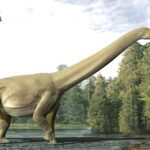A Curtin University-led research team has analysed Australia’s first nearly complete sauropod dinosaur skull found in Queensland, Australia, gaining a better understanding of the animal’s anatomy, relationships to other sauropods, and feeding habits.
The research, published in Royal Society Open Science and completed in collaboration with the Australian Age of Dinosaurs Museum of Natural History, found that the skull – belonging to a dinosaur nicknamed ‘Ann’ – was from the species Diamantinasaurus matildae. Diamantinasaurus is a member of the dinosaur group Sauropoda, known for having small heads, long necks and tails, barrel-like bodies, and four columnar legs.
Lead researcher and palaeontologist Dr Stephen Poropat, from Curtin’s School of Earth and Planetary Sciences, said ‘Ann’ is the first sauropod dinosaur found in Australia to include most of the skull, and also the first Diamantinasaurus specimen to preserve a back foot.
“I was lucky enough to be involved in this Australian-first discovery. Being able to lead the research on these fossils was a huge privilege. This skull gives us a rare glimpse into the anatomy of this enormous sauropod that lived in northeast Australia almost 100 million years ago,” Dr Poropat said.
“In analysing the remains, we found similarities between the ‘Ann’ skull and the skull of a titanosaur called Sarmientosaurus musacchioi, which lived in South America at about the same time as Diamantinasaurus lived in Queensland. These include details of the braincase, the bones forming the back end of the skull near the jaw joint, and in the shape of the teeth (which are conical and curved).
“Our research suggests that Diamantinasaurus was one of the most ‘primitive’ titanosaurs. Gaining a better understanding of this speciesmight explain why titanosaurs were so successful, across so much of the world, right until the end of the Age of Dinosaurs.”
Dr Poropat said the findings support previous theories suggesting that sauropods were using Antarctica as a pathway between South America and Australia between 100 and 95 million years ago.
“We suggest that sauropods were travelling between Australia and South America, via Antarctica, during the mid-Cretaceous. Warmer conditions that far south might have been favourable for them,” Dr Poropat said.
“The window between 100 and 95 million years ago was one of the warmest in Earth’s geologically recent history, meaning that Antarctica, which was more or less where it is now, had no ice. Similarly, Australia, which was much further south than today, was warmer with less seasonality. In that climate, Antarctica was forested, and might have been an attractive habitat or pathway for wandering sauropods.”
The sauropod skull was discovered on Elderslie Station, near Winton in 2018 by the Australian Age of Dinosaurs Museum during its annual dinosaur dig. ‘Ann’ is the third fossil specimen of Diamantinasaurus matildae to have been discovered on Elderslie by the Museum, and the fourth specimen overall.
The full paper is titled, ‘A nearly complete skull of the sauropod dinosaur Diamantinasaurus matildae from the Upper Cretaceous Winton Formation of Australia.’



